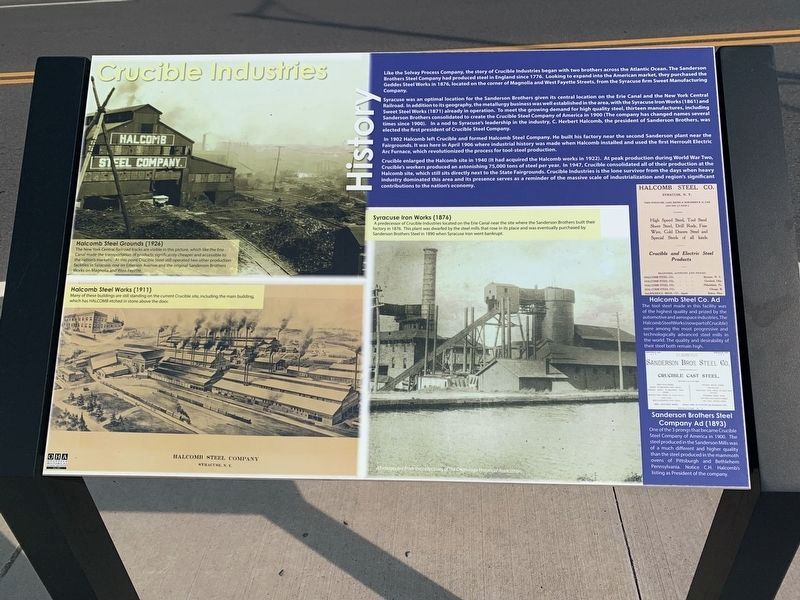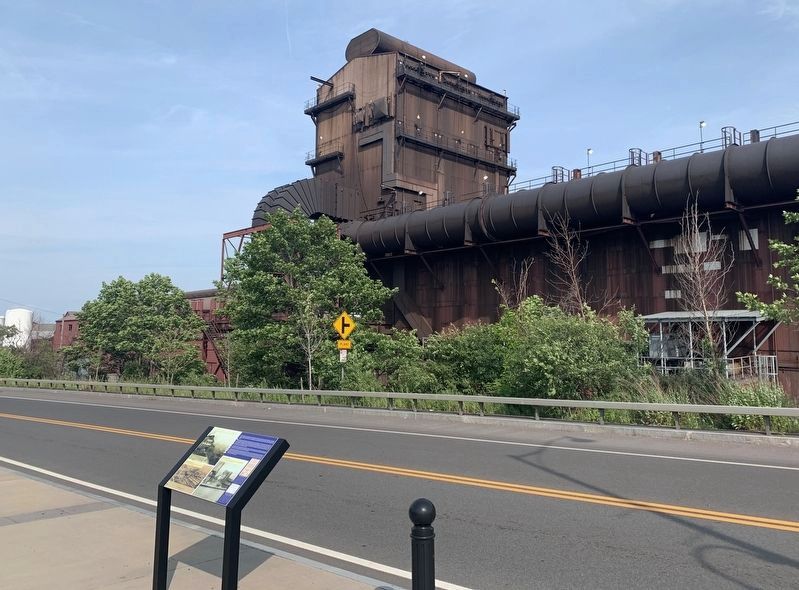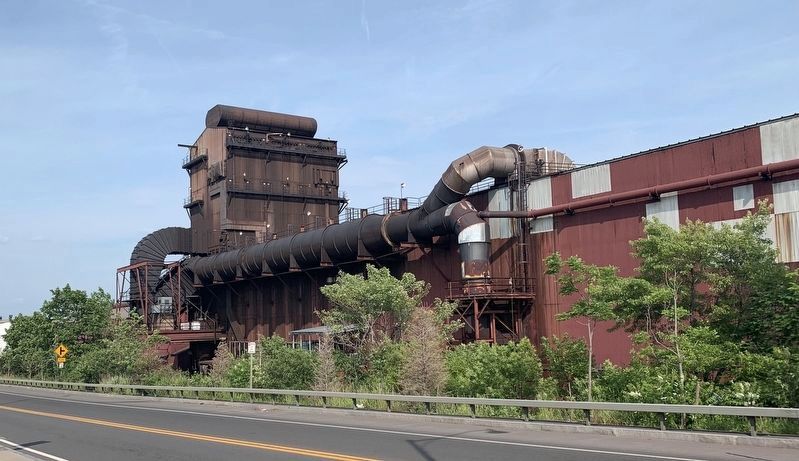Solvay in Onondaga County, New York — The American Northeast (Mid-Atlantic)
Crucible Industries
History
Like the Solvay Process Company, the story of Crucible Industries began with two brothers across the Atlantic Ocean. The Sanderson Brothers Steel Company had produced steel in England since 1776. Looking to expand into the American market, they purchased the Geddes Steel Works in 1876, located on the corner of Magnolia and West Fayette Streets, from the Syracuse firm Sweet Manufacturing Company.
Syracuse was an optimal location for the Sanderson Brothers given its central location on the Erie Canal and the New York Central Railroad. In addition to its geography, the metallurgy business was well established in the area, with the Syracuse Iron Works (1861) and Sweet Steel Works (1871) already in operation. To meet the growing demand for high quality steel, thirteen manufactures, including Sanderson Brothers consolidated to create the Crucible Steel Company of America in 1900 (The company has changed names several times since 1900). In a nod to Syracuse's leadership in the industry, C. Herbert Halcomb, the president of Sanderson Brothers, was elected the first president of Crucible Steel Company.
In 1902 Halcomb left Crucible and formed Halcomb Steel Company. He built his factory near the second Sanderson plant near the Fairgrounds. It was here in April 1906 where industrial history was made when Halcomb installed and used the first Herroult Electric Arc Furnace, which revolutionized the process for tool-steel production.
Crucible enlarged the Halcomb site in 1940 (It had acquired the Halcomb works in 1922). At peak production during World War Two, Crucible's workers produced an astonishing 75,000 tons of steel per year. In 1947, Crucible consolidated all of their production at the Halcomb site, which still sits directly next to the State Fairgrounds. Crucible Industries is the lone survivor from the days when heavy industry dominated this area and its presence serves as a reminder of the massive scale of industrialization and region's significant contributions to the nation's economy.
(upper left photo caption:)
Halcomb Steel Grounds (1926)
The New York Central Railroad tracks are visible in this picture, which like the Erie Canal made the transportation of products significantly cheaper and accessible to the nation's markets. At this point Crucible Steel still operated two other production facilities in Syracuse, one on Emerson Avenue and the original Sanderson Brothers Works on Magnolia and West Fayette.
(lower left photo caption:)
Halcomb Steel Works (1911)
Many of these buildings are still standing on the current Crucible site, including the main building, which has HALCOMB etched in stone above the door.
(lower center photo caption:)
Syracuse Iron Works (1876)
A predecessor of Crucible Industries located on the Erie Canal near the site where the Sanderson Brothers built their factory in 1876. This plant was dwarfed by the steel mills that rose in its place and was eventually purchased by Sanderson Brothers Steel in 1890 when Syracuse Iron went bankrupt.
(upper right illustration caption:)
Halcomb Steel Co. Ad
The tool steel made in this facility was of the highest quality and prized by the automotive and aerospace industries. The Halcomb Steel Works(now part of Crucible) were among the most progressive and technologically advanced steel mills in the world. The quality and desirability of their steel both remain high.
(lower right illustration caption:)
Sanderson Brothers Steel Company Ad (1893)
One of the 3 prongs that became Crucible Steel Company of America in 1900. The steel produced in the Sanderson Mills was of a much different and higher quality than the steel produced in the mammoth ovens of Pittsburgh and Bethlehem Pennsylvania. Notice C.H. Halcomb's listing as President of the company.
All (marker) images are from the collections of the Onondaga Historical Association
Erected by Onondaga Historical Association.
Topics. This historical marker is listed in this topic list: Industry & Commerce. A significant historical month for this entry is April 1906.
Location. 43° 4.211′ N, 76° 12.892′ W. Marker is in Solvay, New York, in Onondaga County. Marker is on Bridge Street (New York State Route 297) 0.1 miles south of State Fair Boulevard, on the left when traveling north. Touch for map. Marker is in this post office area: Syracuse NY 13209, United States of America. Touch for directions.
Other nearby markers. At least 8 other markers are within 2 miles of this marker, measured as the crow flies. The Great New York State Fair (about 500 feet away, measured in a direct line); Solar Salt (approx. 0.4 miles away); The Erie Canal (approx. 0.4 miles away); School House No. 2 (approx. 0.6 miles away); The Solvay Process Company (approx. 0.8 miles away); Jesuit Mission (approx. 1.8 miles away); Lakeland World War II Monument (approx. 1.9 miles away); James Geddes 1798 (approx. 2 miles away). Touch for a list and map of all markers in Solvay.
Also see . . . Crucible Industries. (Submitted on June 30, 2021, by Steve Stoessel of Niskayuna, New York.)
Credits. This page was last revised on July 2, 2021. It was originally submitted on June 29, 2021, by Steve Stoessel of Niskayuna, New York. This page has been viewed 716 times since then and 134 times this year. Photos: 1, 2, 3. submitted on June 29, 2021, by Steve Stoessel of Niskayuna, New York. • Michael Herrick was the editor who published this page.


